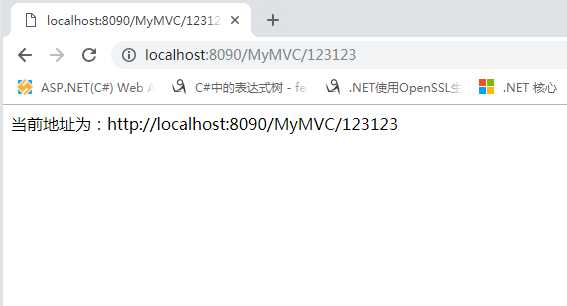.net mvc每次请求时第一个执行的方法是?在那个具体类里面?
Posted
tags:
篇首语:本文由小常识网(cha138.com)小编为大家整理,主要介绍了.net mvc每次请求时第一个执行的方法是?在那个具体类里面?相关的知识,希望对你有一定的参考价值。
当我们对ASP.NET MVC应用程序发起请求的时候,请求会被UrlRoutingModule HTTP Module拦截。HTTP Module是特殊类型的类,它参与每一次页面请求。
以上人CSDN上说的,但是找不着具体的类,为什么?
以下是我的个人的理解,它基于MSDN及《Apress.Pro.ASP.NET.MVC.2.Framework.2nd.Edition.Jun.2010》。
请求经过IIS之后,不管是经aspnet_isapi.dll引用(经典模式下)还是IIS自己引用(IIS7.x集成模式下),第一个被引用的是UrlRoutingModule类的实例。此类唯一的属性是RouteCollection(相信你已经知道它是什么了)。
UrlRoutingModule类里有一个Init()方法,此方法的修饰符、返回值跟签名如下
protected virtual void Init(
HttpApplication application
)
根据MSDN提供的说明,此方法做的应该是根据HttpApplication的Context等属性构造请求处理过程所必需的数据结构,如HttpContext等。
在UrlRoutingModule类里还有一个叫PostResolveRequestCache()的方法,这个方法根据Init()方法所获得的请求信息迭代RouteCollection,直到找到匹配的Route项,PostResolveRequestCache()方法便实例化一个MvcRouteHandler(这个就是楼上所说的东东,此类实现接口IRouteHandler)实例。
获得MvcRouteHandler后,UrlRoutingModule再从此MvcRouteHandler实例里获得另一个类MvcHandler(此类实现接口IHttpAsyncHandler, IHttpHandler, IRequiresSessionState)的实例,这个实例便能根据请求信息获得需要的controller工厂(默认的是DefaultControllerFactory),而此工厂根据路由信息生产一个controller。
然后就是相对熟悉的controller/action了。。
如果不明白的话,请补充问题,希望我能帮到你。
如果这对你有帮助话,请将此标为最佳答案,谢谢。 参考技术A 可以认为是MvcRouteHandler
Asp.Net MVC的路由
通过前面几篇博文的介绍,现在我们已经清楚了asp.net请求管道是怎么一回事了,这篇博文来聊聊MVC的路由。
其实MVC的请求管道和Asp.Net请求管道一样,只是MVC扩展了UrlRoutingModule的动作。我们知道MVC网站启动后第一个请求会执行Global.asax文件中的Application_Start方法,完成一些初始化工作,其中就会注册路由,先来看下面一张图,该图可以直观的展示了MVC执行的流程。


结合上图,我们一起来看看代码是如何实现路由的注册的。
protected void Application_Start() AreaRegistration.RegisterAllAreas(); RouteConfig.RegisterRoutes(RouteTable.Routes); public class RouteConfig public static void RegisterRoutes(RouteCollection routes) routes.IgnoreRoute("resource.axd/*pathInfo"); routes.MapRoute( name: "Default", url: "controller/action/id", defaults: new controller = "Home", action = "Index", id = UrlParameter.Optional );
RouteCollection通过MapRoute扩展方法拿着Url来创建Route并注册到RouteCollection其中,这一点我们通过源码可以看到该方法是如何操作的,该方法通过new一个MvcRouteHandler来创建Route。MvcRouteHandler创建了MvcHandler。紧接着继续往下执行,创建HttpApplication实例,执行后续事件,在PostResolveRequestCache事件去注册UrlRouteModule的动作。
// System.Web.Mvc.RouteCollectionExtensions /// <summary>Maps the specified URL route and sets default route values, constraints, and namespaces.</summary> /// <returns>A reference to the mapped route.</returns> /// <param name="routes">A collection of routes for the application.</param> /// <param name="name">The name of the route to map.</param> /// <param name="url">The URL pattern for the route.</param> /// <param name="defaults">An object that contains default route values.</param> /// <param name="constraints">A set of expressions that specify values for the <paramref name="url" /> parameter.</param> /// <param name="namespaces">A set of namespaces for the application.</param> /// <exception cref="T:System.ArgumentNullException">The <paramref name="routes" /> or <paramref name="url" /> parameter is null.</exception> public static Route MapRoute(this RouteCollection routes, string name, string url, object defaults, object constraints, string[] namespaces) if (routes == null) throw new ArgumentNullException("routes"); if (url == null) throw new ArgumentNullException("url"); Route route = new Route(url, new MvcRouteHandler()) Defaults = RouteCollectionExtensions.CreateRouteValueDictionaryUncached(defaults), Constraints = RouteCollectionExtensions.CreateRouteValueDictionaryUncached(constraints), DataTokens = new RouteValueDictionary() ; ConstraintValidation.Validate(route); if (namespaces != null && namespaces.Length > 0) route.DataTokens["Namespaces"] = namespaces; routes.Add(name, route); return route;
using System; using System.Web.Mvc.Properties; using System.Web.Routing; using System.Web.SessionState; namespace System.Web.Mvc /// <summary>Creates an object that implements the IHttpHandler interface and passes the request context to it.</summary> public class MvcRouteHandler : IRouteHandler private IControllerFactory _controllerFactory; /// <summary>Initializes a new instance of the <see cref="T:System.Web.Mvc.MvcRouteHandler" /> class.</summary> public MvcRouteHandler() /// <summary>Initializes a new instance of the <see cref="T:System.Web.Mvc.MvcRouteHandler" /> class using the specified factory controller object.</summary> /// <param name="controllerFactory">The controller factory.</param> public MvcRouteHandler(IControllerFactory controllerFactory) this._controllerFactory = controllerFactory; /// <summary>Returns the HTTP handler by using the specified HTTP context.</summary> /// <returns>The HTTP handler.</returns> /// <param name="requestContext">The request context.</param> protected virtual IHttpHandler GetHttpHandler(RequestContext requestContext) requestContext.HttpContext.SetSessionStateBehavior(this.GetSessionStateBehavior(requestContext)); return new MvcHandler(requestContext); /// <summary>Returns the session behavior.</summary> /// <returns>The session behavior.</returns> /// <param name="requestContext">The request context.</param> protected virtual SessionStateBehavior GetSessionStateBehavior(RequestContext requestContext) string text = (string)requestContext.RouteData.Values["controller"]; if (string.IsNullOrWhiteSpace(text)) throw new InvalidOperationException(MvcResources.MvcRouteHandler_RouteValuesHasNoController); IControllerFactory controllerFactory = this._controllerFactory ?? ControllerBuilder.Current.GetControllerFactory(); return controllerFactory.GetControllerSessionBehavior(requestContext, text); IHttpHandler IRouteHandler.GetHttpHandler(RequestContext requestContext) return this.GetHttpHandler(requestContext);
using System; using System.Globalization; using System.Runtime.CompilerServices; using System.Web.Security; namespace System.Web.Routing /// <summary>Matches a URL request to a defined route.</summary> [TypeForwardedFrom("System.Web.Routing, Version=3.5.0.0, Culture=Neutral, PublicKeyToken=31bf3856ad364e35")] public class UrlRoutingModule : IHttpModule private static readonly object _contextKey = new object(); private static readonly object _requestDataKey = new object(); private RouteCollection _routeCollection; /// <summary>Gets or sets the collection of defined routes for the ASP.NET application.</summary> /// <returns>An object that contains the routes.</returns> public RouteCollection RouteCollection get if (this._routeCollection == null) this._routeCollection = RouteTable.Routes; return this._routeCollection; set this._routeCollection = value; /// <summary>Disposes of the resources (other than memory) that are used by the module.</summary> protected virtual void Dispose() /// <summary>Initializes a module and prepares it to handle requests.</summary> /// <param name="application">An object that provides access to the methods, properties, and events common to all application objects in an ASP.NET application.</param> protected virtual void Init(HttpApplication application) if (application.Context.Items[UrlRoutingModule._contextKey] != null) return; application.Context.Items[UrlRoutingModule._contextKey] = UrlRoutingModule._contextKey; application.PostResolveRequestCache += new EventHandler(this.OnApplicationPostResolveRequestCache); private void OnApplicationPostResolveRequestCache(object sender, EventArgs e) HttpApplication httpApplication = (HttpApplication)sender; HttpContextBase context = new HttpContextWrapper(httpApplication.Context); this.PostResolveRequestCache(context); /// <summary>Assigns the HTTP handler for the current request to the context.</summary> /// <param name="context">Encapsulates all HTTP-specific information about an individual HTTP request.</param> /// <exception cref="T:System.InvalidOperationException">The <see cref="P:System.Web.Routing.RouteData.RouteHandler" /> property for the route is null.</exception> [Obsolete("This method is obsolete. Override the Init method to use the PostMapRequestHandler event.")] public virtual void PostMapRequestHandler(HttpContextBase context) /// <summary>Matches the HTTP request to a route, retrieves the handler for that route, and sets the handler as the HTTP handler for the current request.</summary> /// <param name="context">Encapsulates all HTTP-specific information about an individual HTTP request.</param> public virtual void PostResolveRequestCache(HttpContextBase context) RouteData routeData = this.RouteCollection.GetRouteData(context); if (routeData == null) return; IRouteHandler routeHandler = routeData.RouteHandler; if (routeHandler == null) throw new InvalidOperationException(string.Format(CultureInfo.CurrentCulture, SR.GetString("UrlRoutingModule_NoRouteHandler"), new object[0])); if (routeHandler is StopRoutingHandler) return; RequestContext requestContext = new RequestContext(context, routeData); context.Request.RequestContext = requestContext; IHttpHandler httpHandler = routeHandler.GetHttpHandler(requestContext); if (httpHandler == null) throw new InvalidOperationException(string.Format(CultureInfo.CurrentUICulture, SR.GetString("UrlRoutingModule_NoHttpHandler"), new object[] routeHandler.GetType() )); if (!(httpHandler is UrlAuthFailureHandler)) context.RemapHandler(httpHandler); return; if (FormsAuthenticationModule.FormsAuthRequired) UrlAuthorizationModule.ReportUrlAuthorizationFailure(HttpContext.Current, this); return; throw new HttpException(401, SR.GetString("Assess_Denied_Description3")); void IHttpModule.Dispose() this.Dispose(); void IHttpModule.Init(HttpApplication application) this.Init(application);
到此,路由的注册动作也就告一段落。那么在理解了MVC的路由后,可以做什么呢?我们可以对路由做一些我们自己的扩展。
可以从三个层面来扩展路由:
一、在MapRoute范围内进行扩展,这种扩展只是在扩展正则表达式
public static void RegisterRoutes(RouteCollection routes) routes.IgnoreRoute("resource.axd/*pathInfo");//忽略路由 //mvc路由规则下的扩展 routes.IgnoreRoute("Handler/*pathInfo"); routes.MapRoute( name: "About", url: "about",//不区分大小写 defaults: new controller = "First", action = "String", id = UrlParameter.Optional );//静态路由 routes.MapRoute("TestStatic", "Test/action", new controller = "Second" );//替换控制器 routes.MapRoute( "Regex", "controller/action_Year_Month_Day", new controller = "First", id = UrlParameter.Optional , new Year = @"^\\d4", Month = @"\\d2", Day = @"\\d2" );//正则路由 routes.MapRoute( name: "Default", url: "controller/action/id", defaults: new controller = "Home", action = "Index", id = UrlParameter.Optional , namespaces: new string[] "Jesen.Web.Controllers" );
二、通过继承RouteBase来扩展Route,这种扩展可以随意的定制规则,而不仅仅是表达式
/// <summary> /// 直接扩展route /// </summary> public class MyRoute : RouteBase /// <summary> /// 解析路由信息 /// </summary> /// <param name="httpContext"></param> /// <returns></returns> public override RouteData GetRouteData(HttpContextBase httpContext)
//此处可以根据自己的需求做一些路由的配置,例如拒绝某个浏览器的访问,检测到Chrome浏览器,则直接跳转到某个url if (httpContext.Request.UserAgent.IndexOf("Chrome/69.0.3497.92") >= 0) RouteData rd = new RouteData(this, new MvcRouteHandler()); rd.Values.Add("controller", "Pipe"); rd.Values.Add("action", "Refuse"); return rd; return null; /// <summary> /// 指定处理的虚拟路径 /// </summary> /// <param name="requestContext"></param> /// <param name="values"></param> /// <returns></returns> public override VirtualPathData GetVirtualPath(RequestContext requestContext, RouteValueDictionary values) return null;
接着在RouteConfig和Global.asax中注册该路由
public static void RegisterMyRoutes(RouteCollection routes)
routes.Add(new MyRoute());
protected void Application_Start()
RouteConfig.RegisterMyRoutes(RouteTable.Routes);
三、扩展Handler,不一定是MvcHandler,可以是我们熟悉的IHttpHandler
/// <summary> /// 扩展IRouteHandler /// </summary> public class MyRouteHandler : IRouteHandler public IHttpHandler GetHttpHandler(RequestContext requestContext) return new MyHttpHandler(requestContext); /// <summary> /// 扩展IHttpHandler /// </summary> public class MyHttpHandler : IHttpHandler public MyHttpHandler(RequestContext requestContext) public void ProcessRequest(HttpContext context) string url = context.Request.Url.AbsoluteUri; context.Response.Write((string.Format("当前地址为:0", url))); context.Response.End(); public virtual bool IsReusable get return false;
RouteConfig.cs文件中配置路由
public static void RegisterMyMVCHandler(RouteCollection routes) routes.Add(new Route("MyMVC/*Info", new MyRouteHandler()));
Global中注册路由
RouteConfig.RegisterMyMVCHandler(RouteTable.Routes);
运行看结果

以上是关于.net mvc每次请求时第一个执行的方法是?在那个具体类里面?的主要内容,如果未能解决你的问题,请参考以下文章